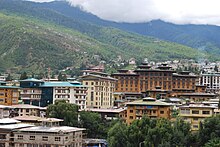Economy of Bhutan
 | |
| Currency | ngultrum (BTN); Indian rupee (INR) |
|---|---|
| 1 Jan – 31 December | |
Trade organizations | SAFTA |
| Statistics | |
| GDP | $5.871 billion (2014) |
| GDP rank | 168th (nominal) / 148th (PPP) |
GDP growth | 6.4% (2014) |
GDP per capita | $7,700 (2014) |
GDP by sector | agriculture: 14.4%, industry: 41.6%, services: 44% (2014)[citation needed] |
| 9.6% (2014 est.) | |
Population below poverty line | 12% (2012) |
| 38.7 (2012) | |
Labor force | 345,800 (2013) |
Labor force by occupation | agriculture: 56%, industry: 22%, services: 22% (2013) |
| Unemployment | 2.9% (2013) |
Main industries | cement, wood products, processed fruits, alcoholic beverages, calcium carbide, tourism |
| External | |
| Exports | $650.3 million (2014) |
Export goods | electricity (to India), cardamom, gypsum, timber, handicrafts, cement, fruit, precious stones, spices |
Main export partners | India 83.9% Hong Kong 10.8% (2013) |
| Imports | $980.6 million (2014) |
Import goods | fuel and lubricants, grain, aircraft, machinery and parts, vehicles, fabrics, rice |
Main import partners | India 72.3% South Korea 6% (2013) |
| Public finances | |
| $713.3 million (2006) | |
| Revenues | $407.1 million (2014) |
| Expenses | $614 million (the government of India finances nearly one-quarter of Bhutan's budget expenditures) (2014) |
| Economic aid | $90.02 million (India) (2005) |
The economy of Bhutan, one of the world's smallest and least developed countries, is based on agriculture and forestry, which provide the main livelihood for more than 60% of the population. Agriculture consists largely of subsistence farming and animal husbandry. Rugged mountains dominate the terrain and make the building of roads and other infrastructure difficult and expensive.
The economy is closely aligned with India's through strong trade and monetary links and dependence on India's financial assistance. Most production in the industrial sector is of the cottage industry type. Most development projects, such as road construction, rely on Indian migrant labor. Model education, social, and environment programs are underway with support from multilateral development organizations.
Each economic program takes into account the government's desire to protect the country's environment and cultural traditions. For example, the government, in its cautious expansion of the tourist sector, encourages visits by upscale, environmentally conscientious tourists. Detailed controls and uncertain policies in areas such as industrial licensing, trade, labor, and finance continue to hamper foreign investment. Hydropower exports to India have boosted Bhutan's overall growth, even though GDP fell in 2008 as a result of a slowdown in India, its predominant export market.
Macro-economic trend
This is a chart of trend of gross domestic product of Bhutan at market prices [1] by the International Monetary Fund:
| Year | GDP (millions of BTN) | GDP (millions of USD) |
|---|---|---|
| 1985 | 2,166 | 175 |
| 1990 | 4,877 | 279 |
| 1995 | 9,531 | 294 |
| 2000 | 20,060 | 460 |
| 2005 | 36,915 | 828 |
| 2008 | 6969 | 1280 |
Bhutan's hydropower potential and its attraction for tourists are key resources. The Bhutanese Government has made some progress in expanding the nation's productive base and improving social welfare. Model education, social, and environment programs in Bhutan are underway with support from multilateral development organizations. Each economic program takes into account the government's desire to protect the country's environment and cultural traditions. For example, the government, in its cautious expansion of the tourist sector, encourages visits by upscale, environmentally conscientious tourists. Detailed controls and uncertain policies in such areas as industrial licensing, trade, labor, and finance continue to hamper foreign investment.
In 2004, Bhutan became the first country in the world to ban smoking and the selling of tobacco.
Other statistics

Industrial production growth rate: 9.3% (1996 est.)
Electricity:
- production: 2 TWh (2005)
- consumption: 380 GWh (2005)
- exports: 1.5 TWh (2005) (exports electricity to India)
- imports: 20 GWh (2005)
Electricity – production by source:
- fossil fuel: 0.39%
- hydro: 99.61%
- nuclear: 0%
- other: 0% (1998)
Oil:
- production: 0 barrels per day (0 m3/d) (2005)
- consumption: 1,200 barrels per day (190 m3/d) (2005 est.)
- exports: 0 barrels per day (0 m3/d) (2004)
- imports: 1,138 barrels per day (180.9 m3/d) (2004)
Agriculture – products: rice, corn, root crops, citrus, foodgrains, dairy products, eggs
Currency: 1 ngultrum (BTN) = 100 chetrum; Indian rupee (INR)
Historic exchange rates:
2006 2005 2004 2003 2002 2001 1999 Ngultrum per US$1 45,279 44,101 45,317 46,583 48.61 47,186 43,055
See also
- Agriculture in Bhutan
- Banking in Bhutan
- Mining in Bhutan
- Fishing in Bhutan
- Forestry in Bhutan
- Bhutanese ngultrum, currency
References
 This article incorporates public domain material from The World Factbook. CIA.
This article incorporates public domain material from The World Factbook. CIA. This article incorporates public domain material from U.S. Bilateral Relations Fact Sheets. United States Department of State.
This article incorporates public domain material from U.S. Bilateral Relations Fact Sheets. United States Department of State.
External links
- Global Economic Prospects: Growth Prospects for South Asia The World Bank, 13 December 2006

